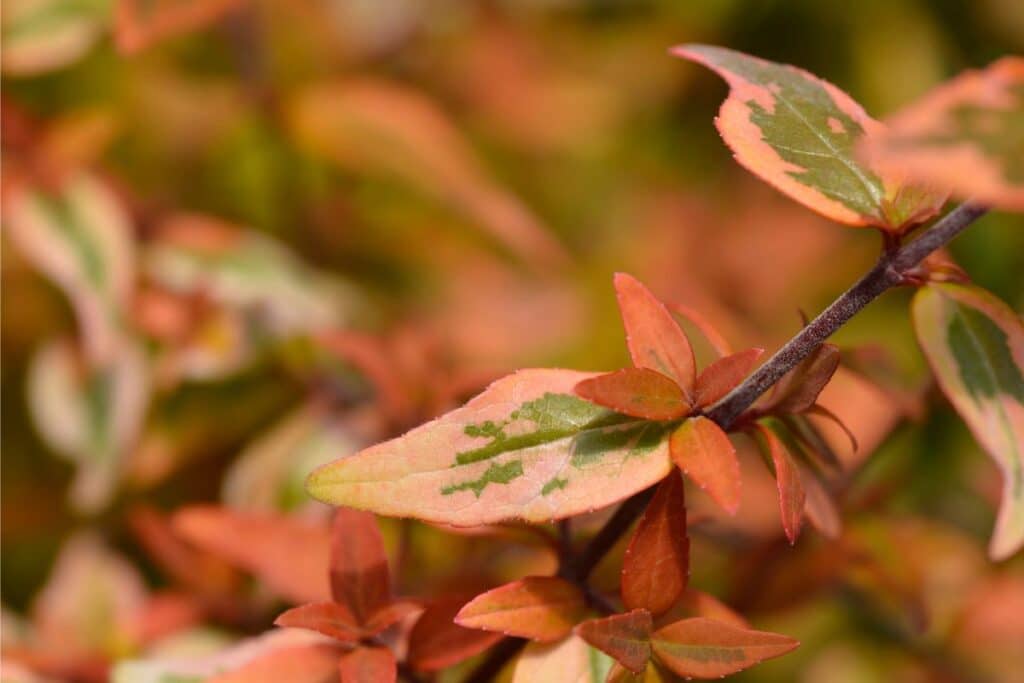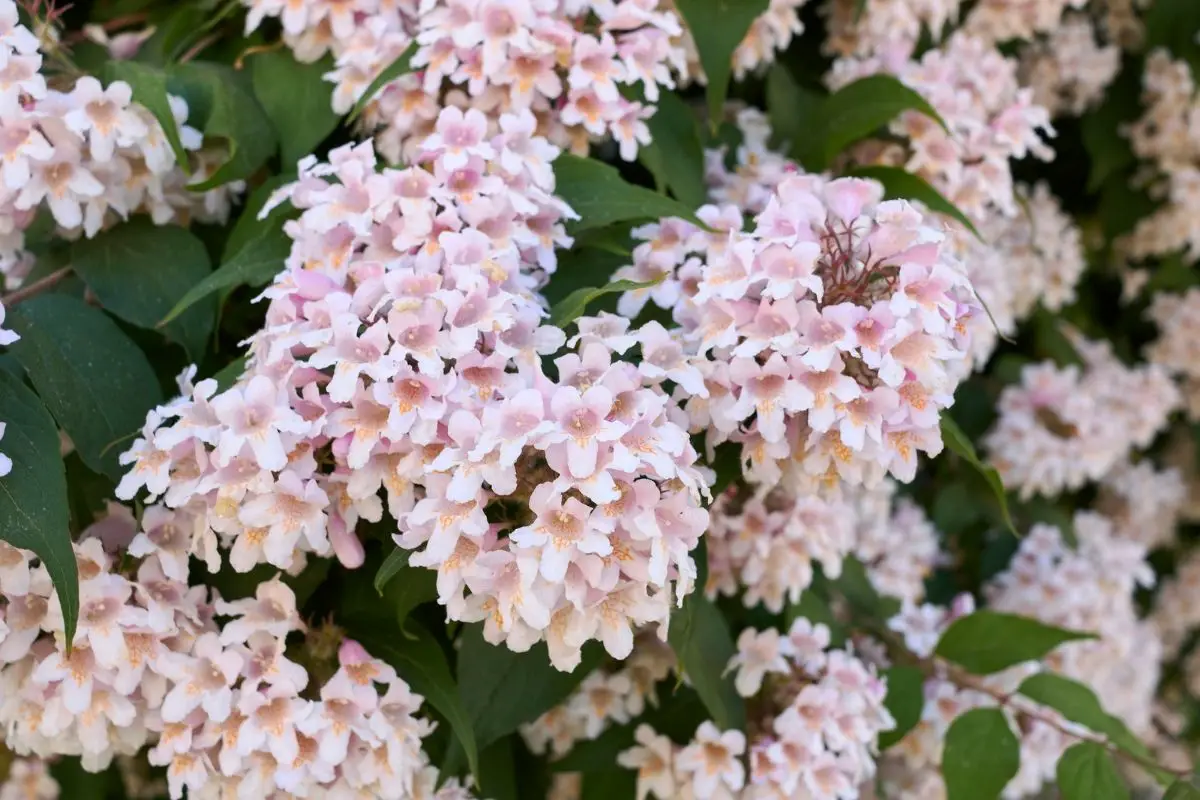An abelia is an elegant shrub with arching branches and long-lasting tubular flowers that will bring joy to your garden. But you may be wondering what other plants you could grow with the abelia bush.
Growing carefully selected plants that work together is one way that landscapers and gardeners get the most from the space available. Used successfully, this planting method can extend the season of interest considerably, maybe even providing you with color year-round.
What Plants to Choose to Grow alongside Abelia
Planting companion plants always requires a little foresight and increased planning. First, you should make sure you are fully conversant with the potential size of your abelia and the growing space available. Abelias come in a range of sizes, from low-growing plants to abelia bushes that will grow about 10 feet in both directions.
The selection of your companion plants should also incorporate those which have similar sun, soil, and watering requirements, so consider the summarized care guide below before choosing the plants to grow alongside your abelias.

In Brief: Ideal Growing Conditions for Abelia
Once established, the abelia requires little in the way of maintenance and in warmer zones, it will retain its foliage throughout the winter.
Sunshine
Not a fussy plant, but to get the best from the abelia, you should make sure that it receives around six hours of sunshine. If you plant in the shade, you will get fewer blooms and less vivid color from your foliage.
Soil
The ideal soil for an abelia should be slightly acidic and enriched with plenty of organic matter. However, the most important requirement is that the soil must be free draining. An abelia will die if its roots are left to sit for extended periods in cool, waterlogged soil.
Water & Fertilizer
Whilst young, an abelia plant needs to be watered regularly, especially during the summer or extended spells of heat. Once its roots are established, the abelia can absorb goodness and water from the soil, so less frequent watering is required.
An abelia bush doesn’t require much feeding, although it will benefit from a light application in the early spring. This will result in an increased and more intense color.
Temperature and Humidity
Different varieties of abelia have different levels of hardiness, so you need to make sure that the variety you choose is adapted to your zone.
The one thing that is common to all abelias is their dislike of high humidity levels in the soil. The soil should dry out between watering. Abelia roots should not be left in heavy, saturated soil, especially during the cooler months.
Pruning
The natural shape of the abelia is elegant, and it looks most attractive when allowed to retain its graceful, arching habit. Pruning is not essential, but you may wish to thin the shrub to encourage new growth and to help it to keep its pretty shape.
The most commonly grown abelia shrub is A.grandiflora (glossy abelia). Like all abelias, this variety blooms on new wood. Pruning should therefore be carried out in the late winter or very early spring. If you prune too late, once the new growth has emerged, you will lose flowers.
Pests, Diseases and Other Problems
If your abelia is planted in damp, heavy soil, then it might well suffer from a fungal disease such as mildew. But if planted in well-drained soil, then the abelia shouldn’t suffer from such problems.
Relatively few pests trouble the abelia, and if it does suffer from an aphid attack, this will only cause superficial damage.
Deer are not naturally attracted to abelias unless there is an extreme and prolonged cold spell which leads them to seek out any potential food source.
Successful Companion Plants to Grow with Abelia
For Hedging, Screening, or Division of Spaces
If you are using Abelia grandiflora as a hedging plant, it grows relatively fast. In just a few seasons, it will give you moderate height (around 4½ to 5 feet). If kept trimmed on the sides, the abelia will produce a pretty, fragrant, evergreen hedge if it is planted in a sunny position.
You can choose whether you want your hedge to be formal or casual in form, by adjusting the aggressiveness of your pruning accordingly.
You can successfully integrate the spirea flowering shrub into your abelia hedge, and this will give an abundance of white flowers and fairly dense foliage. Like the abelia, the spirea shrub is a hardy plant and requires minimal care. It’s a good companion plant for abelia since it is deciduous and flowers profusely early in the year.
The 2 most traditionally used garden hedging varieties are Spiraea arguta or Spiraea vanhoutti.
Today, newer cultivars of spiraea shrubs have appeared, but these are generally dwarf varieties and less useful for use as hedging plants.
Container plant
Abelias have become a popular flowering plant to grow in containers. This is mainly because the abelia shrub is evergreen and provides almost year-round color interest. And also, perhaps, because it is so easy to care for!
If grown in pots, abelias will retain their attractive shape, but they need to have a large pot due to the arching shape of their branches. The color of the pot chosen is also important and should complement and not overpower the color of the plant’s foliage or flowers.
Because the soil in pots tends to dry out more quickly than the ground, more frequent watering will be required. Nevertheless, it is important to make sure that the abelia isn’t left sitting in soggy soil.
The A.grandiflora “Kaleidoscope” is a perfect choice for a pot-grown abelia as it will not grow more than 2 feet in either direction and will retain a tidy, dome shape. Being semi-evergreen and with attractive variegated foliage, it will bring interest to the patio or deck all year round.
You can plant this abelia with other shrubs, grasses, bamboo, a flowering perennial, or even with a trailing fruit!
How about trying it with purple heather?
There are so many possibilities for companion planting here!
Background plant
If you choose a taller variety of glossy abelia, its glossy foliage will make a perfect background for a mixed perennial border and will show off your border flowers.
Alongside small specimen trees
Abelias do well in a mixed shrubbery, and smaller varieties can be planted successfully in front of small specimen trees, mixed grasses, or bamboos. Just make sure that your abelia is still able to get sufficient sunlight.
Ground cover along a pathway
The choice of plants for edging a path or drive can make a difference to the overall look of your garden. And a living border is much more in tune with a garden than one which is man-made.
Having the natural effect of a plant-lined path doesn’t have to mean a lot of work. You need to choose a plant that requires minimum maintenance and which will stay tidy and compact without the need for a lot of pruning.
A.grandiflora “Kaleidoscope” is a perfect choice for edging, as its dwarf size means that it will retain its pretty rounded shape. Some excellent Abelia Kaleidoscope companion plants include a variety of short growing ornamental grass, such as the fountain grass (Pennisetum alopecuroides). Like abelia, this plant needs a sunny spot, but it will reward you with attractive late-season flower heads that will sway in the breeze.
Conclusion
It is hard to think of a shrub that is as versatile as the abelia. There are so many uses for abelia plants, all of which will reward you with almost year-round color, glossy leaves, an abundance of scented flowers. It’s not surprising that they’re a gardener’s favorite, abelias do have it all!
~ image source: depositphotos/simonapavan

